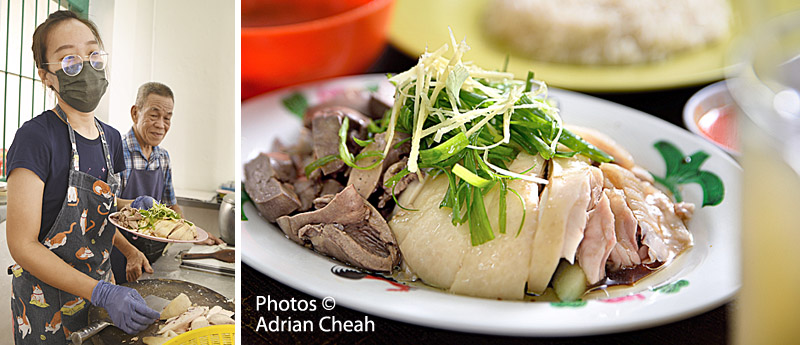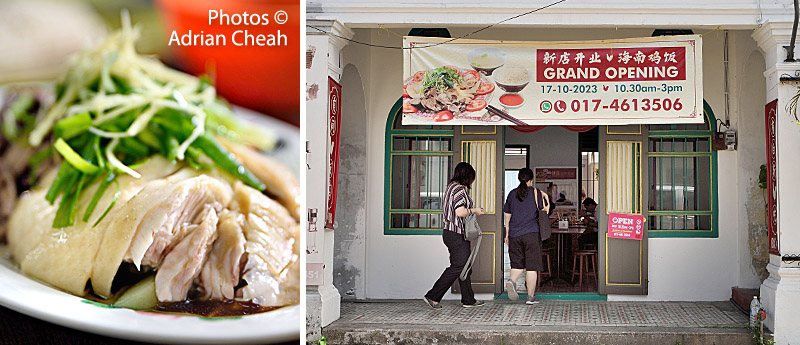Sri Bahari Hainan Chicken Rice – legacy on a plate

Hainanese chicken rice is an uncomplicated dish that comprises succulent poached chicken and aromatic rice cooked with chicken fat and stock accompanied by a chilli dipping sauce and a bowl of clear chicken soup. Some vendors may also serve it with other condiments like a ginger dipping sauce or some thick soy sauce.

In the late 1940s, Mr Ho Jong Kwang, a Hainanese emigrant from Wenchang in the northeastern part of Hainan Island, embarked on a journey to Penang in pursuit of a brighter future. Little did he know that destiny had a love story scripted for him as well. Fate intertwined his path with that of the charming Ms Tham Kuan Haw from Butterworth; together, they nurtured a love that blossomed into a beautiful family, embracing three daughters and a son. In the 1960s, Mr Ho, true to his Hainanese roots, decided to start his own business serving what he knew best – Hainanese chicken rice. With his wife by his side, he established a quaint stall at Kheng Pin kopitiam (coffee shop), nestled at the intersection of Penang Road and Sri Bahari Road. Over time, the stall garnered a string of devoted clients, becoming a popular spot to enable one to savour authentic Hainanese chicken rice.

Left: Toay Heng's parents – Mr Ho Jong Kwang and Ms Tham Kuan Haw and in the group photo o the right: Ms Tham, a dedicated mother to her four children.
Later, seeking to enhance the family income, Mr Ho secured a role as a shipboard chef, while Ms Tham steadfastly tended to the stall. From a tender age, all four children lent a hand, pitching in with service and dishwashing until their secondary school years. Remarkably, Toay Heng, their daughter, persisted in supporting Ms Tham before her secondary school days. Consequently, as the years unfolded and Ms Tham retired, Toay Heng, having been her mother's dedicated companion for decades, seamlessly assumed control of the cherished stall. Alongside her husband, Mr Wong Soon Wei, she continued to serve her father's popular chicken rice that resonated with the locals and visitors alike. In September 2023, marking decades of dedication to the art of perfecting Hainanese chicken rice, Toay Heng decided to stop and give up the very spot her father had set up.

It was a significant sacrifice for Toay Heng, the second daughter in the family, to discontinue her schooling while in primary school and assist her mother in managing the chicken rice stall. Left, a recent photo of Tong Heng and Mr Wong..
Passing the reins to the next generation, Toay Heng and Mr Wong have entrusted their culinary legacy to their children. Their daughter, Yi Ting, manages the Hainanese chicken rice shop at 14, Sri Bahari Road, with the assistance of her father. Meanwhile, Toay Heng has dedicated her expertise to supporting her son, Wan Foong, at his equally renowned establishment situated at 122H, Hutton Lane. Wan Foong started his business in 2012.

It is heartening to witness the continuation of their grandfather's legacy, a tradition that has endured for over 60 years. Through the dedication and passion of the family's younger generation, they are here to ensure that the flavours and traditions of Hainanese chicken rice persist in Penang for years to come.

Wenchang chicken available online. The chickens mature about 4 to 4.5 months, when the hens begin to lay eggs.
The recipe for this dish is adapted from early Chinese immigrants from Hainan Island, off the southern coast of China. Back in Hainan, locals refer to the dish as "Wenchang chicken". For this particular dish, a lean, free-range bird is best as its meat is naturally sweet and has a thin skin. The preferred cooking method among the locals is to poach the chicken. The result is a tender yet chewy chicken, often seasoned with a simple sauce.

In the 1920s, economic, social and political factors were among the main causes attributed to the massive migration from Wenchang to Nanyang (used by the Chinese to refer to regions in the south, especially those beyond China, including Southeast Asia). This migration occurred via junks from Port Qinglan (in central Wenchang) and Port Puqian (north-eastern Wenchang near Haikou). Hainan Map: Library of Congress, Geography and Map Division.
In the 1920s, the Hainanese were among the final wave of Chinese immigrants to reach Penang. As other dialect groups had already established dominance in most trades, these latecomers found themselves taking on roles as cooks and houseboys (domestic helpers) in British homes and establishments. The Hainanese cooks were taught on-the-job how to prepare British dishes and were also introduced to local ingredients and spices. They eventually evolved their cooking repertoire, infusing their creations with local flavours to suit the taste buds of Penangites and the colonial British. Thus, the Hainanese cuisine in Penang, and at large, in Malaysia and Singapore, is unique in its own way and cannot be found elsewhere, not even in Hainan Island.
The same narrative holds true for the Wenchang chicken, which, in Penang, has evolved to align with available ingredients and evolving tastes. Hainanese cooks began incorporating local chicken breeds, diverse rice varieties and an array of sauces, crafting a version of Hainanese chicken rice that we have come to love.

In a South China Morning Post article* published on 27 February 2021, Singaporean heritage enthusiast Brian Wong shared insights from his 2019 visit to Hainan, where he delved into the island's rich food traditions. Wong remarked, "The few shops I visited in Hainan didn’t serve it with chilli, but instead small yellow capsicum and the dip is a simple oil with calamansi, garlic and ginger. The focus is really the chicken. For the rice, it really just tastes like plain rice, or [they] add some chicken stock. It is not like the yellowish greasy rice served in Singapore or Malaysia”.

Here in Penang, while the cooking method remains rooted in its Chinese origins, it takes on a few distinctive twists. The chicken undergoes a process of poaching in chicken stock until cooked before being immersed in an ice bath. This not only halts the cooking process but also results in a smooth, slightly springy skin and a layer of congealed fat between the skin and flesh. Such a method ensures that the meat retains its tender quality. Yi Ting emphasised that, although there may not be a secret recipe for cooking the chicken, these routine techniques have become second nature to her. She also adheres to the traditional Hainanese method of laying the cooked chickens on trays, as hanging them could cause the juices to drip out. However, for the camera, I did ask her to hang two up.

When my Mum prepares "pek cham kay" (Chinese poached chicken) at home, she deploys the same cooking method and concludes by rubbing the cooked chicken with a generous amount of Ghee Hiang's aromatic sesame seed oil and lard. Mum emphasises the preference of selecting a larger-size chicken that has laid eggs, noting, "You need a chicken with fat for this dish". She also advises washing the chicken thoroughly with salt and tapioca flour prior to cooking to eliminate any gamey smell.

While the chicken takes the spotlight, I firmly believe that the quintessential element of Hainanese chicken lies in the rice. Rice grains are first sautéed in chicken fat, garlic, ginger and shallots before being cooked in chicken stock. Knotted pandan leaves would also be added to the pot of rice during the cooking process. Heaven forbid the use of butter or margarine in the rice! The rice should be fluffy and not greasy. Choosing a better quality of rice makes a big difference, although I understand that to make it commercially viable, compromises may be made. Another crucial component is the chilli dipping sauce, a vital companion that must strike the perfect balance between spiciness and sourness.

For an authentic Hainanese chicken rice experience, look no further than Sri Bahari Road Hainan Chicken Rice at 14, Sri Bahari Road, Penang.
-------------------------------------
Written and photographed by Adrian Cheah
© All rights reserved
28 December 2023

Sri Bahari Hainan Chicken Rice
14 Sri Bahari Road, 10050 George Town, Penang
Tel: +6017-461 3506
Open: 10.30 am – 3 pm except Thursdays
-------------------------------------
PS: Determining which country deserves to claim Hainanese chicken rice is complicated because Singapore and Malaysia were once the same country. The first recorded chicken rice stall in Singapore was started in 1940 by Wong Yi Guan. However, Malaysians lay claim to an even earlier originator established in the 1930s called Nam Heong Chicken Rice in Klang. To me, Hainanese chicken rice has become a shared cultural heritage, with each country contributing to its diverse and rich culinary landscape.
* South China Morning Post: "The Hainanese chicken rice debate: Singapore and Malaysia both lay claim to it – who’s right, or are they both wrong?", 27 February 2021.